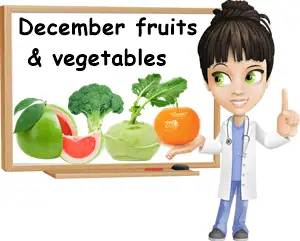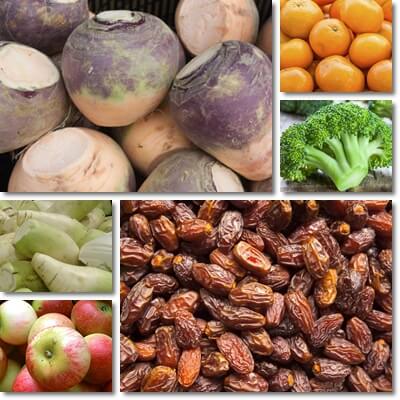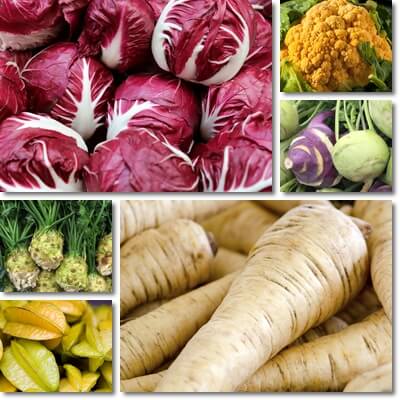Are you looking for ideas on what to eat in December? There are so many fruits and vegetables in season in December, from fresh citrus fruits such as mandarins and tangelos to healthy root vegetables such as celeriac, turnips, Daikon radishes and black radishes. There are dozens of late-season apple varieties available in December as well, not to mention tropical fruits such as star fruit, kumquat, but also kaki or persimmon.
If you’re looking to eat what’s in season, know that there are so many options to choose from. Contrary to popular belief, December is not just for cranberries, oranges, carrots and cabbage – the variety of seasonal foods is astounding. See below a long list of all the healthy fruits and vegetables in season in December and some of their biggest benefits for health to get you excited about grocery shopping this time of the year.

Seasonal December foods list
Apples
Late-season apples, also known as winter apples, are varieties of apples harvested late-fall to early winter, but which store extremely well. Under ideal conditions, some varieties can be stored until April. Ashmead’s Kernel, Baldwin, Black Twig and Braeburn apples, Idared, Melrose and Mutsu apples, Pink Lady, Rome apples, Staymans apples and many more varieties are available all of December to eat fresh and use in salads, sauces, stews, mashes, pies and all sorts of baked goods.
Avocado
Thanks to multiple harvest seasons, avocados are essentially available year-round these days, but they are in fact in season in December in Mexico, New Zealand, Australia etc. Eat the seasons with avocado this winter and get lots of potassium for lower blood pressure numbers, B vitamins for more energy and zinc and vitamin C for better immunity.
Broccoli
A classic winter seasonal food, broccoli is one of the healthiest vegetables you can eat this December. Broccoli contains natural organic sulfur compounds whose metabolites have scientifically proven anticancer properties. Broccoli is also nutritionally-dense, high in vitamin C, B vitamins, potassium, phosphorus and manganese.
Broccolini
The atypical-looking broccoli is actually a cross between broccoli and Chinese kale. Broccolini is more tender and somewhat sweeter than broccoli, with long, thin stalks and fewer florets, and it’s in season right now. Get your fill of B vitamins, vitamins A, C and K and a range of dietary minerals with this low-calorie veggie.

Black radishes
Black radishes are a variety of winter radish with dull, brown-black or jet black skin and glossy white flesh. Black radishes help lower blood cholesterol and hepatic cholesterol levels, prevent cholesterol gallstones as well as exert a hepatoprotective action, limiting and actively combatting liver damage. Also see the benefits of black radish juice.
Belgian endives
If you like the taste of bitter, then Belgian endives are a great December food for you. Belgian endives are a good source of vitamin B1, vitamin B9 and manganese, and low in calories (only 17 kilocalories per 100 g). Eating Belgian endives is good for the normal development of the baby during pregnancy and contributes to heart and muscle health. You can also use Belgian endives root to make a caffeine-free coffee substitute.
Cabbage
A traditional winter vegetable in season in December, cabbage is plain healthy whether it’s green, red or purple. It’s high in vitamins C and K with anti-inflammatory benefits and benefits for teeth and gums. It’s also a generous source of vitamins B6 and B9 with anti-anemia properties and benefits for pregnant women. Cabbage also contains organic sulfur compounds with anticancer properties. But if you are on anticoagulants, limit intake because vitamin K in cabbage promotes blood coagulation.
Carrots
Carrots are a cool season crop and late fall-early winter is one of the two major harvest seasons for them, meaning carrots are in season in December. For a traditional side dish for the winter holidays choose orange carrots with a high content of pro-vitamin A and benefits for visual acuity and color vision. Choose yellow carrots with a high content of xanthophyll antioxidants shown to lower risks of cataract and age related macular degeneration. Go for purple carrots and black carrots high in anthocyanins with anticancer properties or red carrots high in lycopene with blood pressure lowering properties.
Cauliflower
Another traditional winter veggie, cauliflower is in full season in December and a healthy addition to any diet. Classic white cauliflower is perfect for a winter table decor and high in vitamin C and vitamins B5, B6 and B9. Purple cauliflower provides pigmented anthocyanin antioxidants with anti-inflammatory and anticancer properties. Orange cauliflower is high in pro-vitamin A beta-carotene and contains lutein and zeaxanthin, antioxidants with benefits for eyesight.
Celeriac
Unless you’re allergic to celery, celeriac is a great winter vegetable to add to your diet this December. Celeriac is low in calories and thus good for both losing weight and keeping weight off during the holiday season. High in phosphorus and a good source of magnesium, it promotes bone health. Celeriac is also a generous source of B vitamins and iron to boost energy levels and mood this holiday season.

Clementines
Clementines are tangors, hybrids of the common sweet orange and mandarin oranges. Clementines are a great pick for a seasonal December fruit because they are easy to peel and high in vitamin C (close to 60% recommended intake per 10o g of fruit). They are rich in carotenoid antioxidants with vitamin A activity and benefits for eyesight, skin and the immune system. You can also get seedless clementines which make a great snack for kids.
Cranberries
It doesn’t get more traditional than cranberries for the winter holidays. Although cranberries get harvested as early as mid September some years, they are still in season in December. While too sour to eat raw, they are quite palatable cooked and make a great juice and dried natural supplement. Cranberries provide proanthocyanidin antioxidants shown to help with urinary tract infections.
Daikon radishes
Daikon radishes are a variety of white winter radish originally from Asia. Daikon radishes are available at different times during the year, but November-December is a great season for them since cold weather makes them taste better. You can eat Daikon radishes raw, finely sliced, and get lots of vitamin C with antioxidant and anti-inflammatory benefits. The root vegetable is a source of potassium and magnesium with benefits for high blood pressure, contains natural organic sulfur compounds with anticancer properties and is very low in calories.
Dates
Dates are harvest September through October, but because they are dried fruit, they store extremely well and can technically be considered in season in December. Dates are naturally high in potassium and magnesium and provide benefits for high blood pressure. They are also high in vitamins B5 and B6 and help combat anemia, tiredness and fatigue, muscle cramps and skin conditions such as seborrheic dermatitis.
Grapefruit
For those of you that like bitter, grapefruit is a great choice, and it’s in season in December. White, pink and dark red grapefruit are healthy fruits to eat for the winter holidays. Due to its bitter flavors, grapefruit is a digestif. Low in acidity, it’s safe to eat if you have acid reflux disease. Grapefruit is also high in vitamin C with roughly 40% of the recommended daily intake for an average adult per 100 g. However, limit intake of grapefruit and grapefruit juice if you are currently on any medication (e.g. diabetes, high blood pressure etc.) because the fruit and juice can affect how various medications are metabolized.
Hawthorn berries
Hawthorn berries, also called haws, are an Old World fruit. While not very appealing as they are, hawthorn berries are a great December fruit to consider including in your diet. You can make a therapeutic hawthorn tea or dry and grind the berries and use as a dietary supplement to help lower blood pressure numbers and manage heart failure symptoms. Find out more about hawthorn for high blood pressure.
Kaki or Persimmon
In season in December, sweet kaki or persimmon fruit are a vibrant choice to add to your winter holidays tablescape. You can eat the fruit as it is or cook with it (persimmon pudding is an old traditional Christmas recipe). Either way, you will be getting good amounts of vitamins C and B6 as well as the antioxidant mineral manganese. The seasonal fruit is also high in pro-vitamin A antioxidants and lutein and zeaxanthin with benefits for eyesight.
Kumquat
Kumquat fruit, alternative spelling: cumquat, is an orange-like citrus fruit about the size of an olive. The bright orange citrus fruit is harvested November through January and December through April, depending on the variety and regions, but it’s a seasonal winter fruit. If you kumquats taste sweet, eat them fresh, either alone or in winter-style salads. If your kumquats taste too sour or acidic, you can make a seasonal winter marmalade. Kumquats are high in vitamin C, iron, magnesium and manganese and contain lutein and zeaxanthin antioxidants.
Kohlrabi
Kohlrabi is a sort of cabbage-like turnip, mild-tasting, broccoli-like, but healthy, and in season in December. It’s an excellent source of vitamin C with 75% of the recommended daily intake for an average adult per 100 g, but needs to be eaten raw because cooking heat destroys vitamin C. Kohlrabi is a great source of dietary magnesium and potassium and thus one of the best vegetables for anyone with high blood pressure. You can change up your holiday mash to kohlrabi, turnip and apple puree.
Mandarin oranges
The original orange, the mandarin or the mandarin orange is a smaller, sweeter, orange-like citrus fruit, perfect for the holidays. Peak season for mandarins is December through January. Mandarins are easier to peel than oranges and separate into segments easily, making a great snack. The winter seasonal fruit is a good source of vitamin C and contains small amounts of pro-vitamin A, vitamins B1, B5, B6 and B9, potassium, magnesium and phosphorus.
Navel oranges
Navel oranges are a variety of the common sweet orange with a protuberance at the end opposite to the stem which is, in fact, an underdeveloped fruit. Navel oranges are in season November through April or May, but taste their best December through January. The seasonal winter fruit is actually the best eating orange and a good source of vitamin C, B vitamins and dietary fiber, as well as pigmented antioxidants. Cara Cara oranges, a variety of red navel oranges, are a source of red carotenoid antioxidants, primarily lycopene, with free radical-scavenging, anti-inflammatory and blood pressure lowering properties.
Oranges
The common sweet orange is the ultimate seasonal winter fruit. It’s in season late fall and all through winter and spring, roughly November-December to April-May (depends on the variety). Regular sweet oranges are tart and acidic and only slightly sweet, but so fragrant. Or you can choose acidless oranges if you have issues with gastritis or acid reflux disease. Or opt for blood oranges rich in anthocyanin antioxidants with scientifically-proven anticancer properties. See what are the 18 different types of oranges.
Oroblanco (Sweetie)
Oroblanco or Sweetie is a cross between a pomelo and a grapefruit and it’s in season September through December. It’s a fairly pleasant-tasting citrus fruit, quite similar to pomelo. Oroblanco is a good source of vitamin C and contains modest amounts of vitamins B1, B2, B3, B5 and B6, potassium and a few other dietary minerals. See the benefits of Oroblanco.
Parsnip
Bland to light-flavored, parsnip doesn’t impress flavor-wise. However, this seasonal winter vegetable is one of the healthiest December foods you can eat. Parsnip is a source of chemicals such as falcarinol, farcalindiol, methyl-falcarindiol and panaxydiol with scientifically proven anticancer properties. Regular consumption can help lower blood pressure, exerts anti-inflammatory benefits and is good for pregnant women, supporting the normal development of the baby during pregnancy.
Pomegranate
Pomegranates are in full season in December in the Northern hemisphere. In fact, pomegranate season starts September-October and last till January-February. Research has revealed a compound derived from pomegranates, Urolithin A, exerts measurable antiaging benefits at cellular level. More exactly, Urolithin A, which results from gut bacteria processing ellagitannins in pomegranate, has been found to sustain mitochondria recycling, increasing lifespan in C. elegans nematodes by 45% and improving running endurance and capacity for exercise in mice by 42%.
Pomelo
The predecessor of the common sweet orange, pomelo is in full season in December, just in time for the winter holidays. It’s only faintly bitter and not acidic like regular oranges, but still aromatic, perfect for anyone looking for something in between. Pomelos are extremely high in vitamin C and provide anti-inflammatory benefits as well as stimulate the production of collagen in the skin for improved skin elasticity and fewer wrinkles.
Radicchio
This December eat radicchio, also known as Italian chicory. The red-violet tinged veggie and Italian cuisine favorite is crisp, crunchy and bitter. Radicchio is an extreme source of vitamin K which supports blood coagulation and anti-inflammatory processes, and provides good amounts of vitamin B9 for pregnant women, vitamin C and zinc for immune system support and potassium for better blood pressure numbers.
Rose hips
Unless the birds have gotten to them, you can still find rose hip berries on the plant in December. Even with all the frosts and snow, rose hips continue to retain their therapeutic properties. While not palatable fruits, you can still use them to make a therapeutic rose hip tea with benefits for high blood pressure and anti-rheumatic action. Or consider natural vitamin C supplements from rose hips to boost your immunity.
Rutabaga
Rutabagas are turnip-like root vegetables available starting September-October and up until June. But like all cool season vegetables, they taste their best in winter. Rutabaga is a good source of vitamins B1, B3, B6 and B9, magnesium, manganese, phosphorus and potassium. This December make a unique puree from roasted rutabaga and carrots with milk or cream and butter, or a novelty rutabaga, parsnip and yellow carrot cream soup.
Satsumas
The satsuma mandarin or tangerine is a favorite seasonal citrus fruit. It’s seedless and easy to peel, separates into segments easily and tastes sweet, traits that are at the center of its appeal. Satsumas provide good amounts of vitamin C and small amounts of several B vitamins and dietary minerals, contributing to nutritional status.
Star fruit
In season in December, start fruit or carambola is quite the presence with its star-shaped cross section. Star fruits are a generous source of vitamin C with anti-inflammatory and antioxidant benefits, and contain good amounts of vitamin B5 to combat tiredness and fatigue, low mood and sleep problems. You can eat them as a snack or use them to decorate the table and baked goods such as cakes and pies.
Sugar Belles
Available in December, Sugar Belles are a cross between Honeybells and Clementines. Sugar Belles are only available for a short window of time during the winter, but make a delicious snack, sweet and moderately nutritious.
Tangerines
Tangerines or tangerine oranges are hybrids of the mandarin orange. Tangerine season starts November-December and extends till May. Tangerines have better flavor than regular sweet oranges and are less acidic, but also less sweet than mandarins, and somewhat flattened at the top and base. A good source of vitamin C, they have anti-inflammatory benefits and boost collagen production in the skin for better skin elasticity and fewer wrinkles.
Tangelos
Tangelos are essentially a cross between a mandarin orange or a mandarin orange hybrid, and a pomelo. They are somewhat bell-shaped, lower-acidity than regular oranges and quite sweet, hence the alternative name Honeybells. December through January is peak season for tangelos and juicy varieties such as Minneola and Orlando are international favorites. Better for acid reflux than common sweet oranges, and a good source of vitamin C, tangelos make a great snack as they are.
Turnips
In season October through March, turnips are a great food to consider eating this time of the year. With only 22 kilocalories per 100 g, they are good for keeping the weight off during the holiday season. Smaller, more tender turnips are best eaten raw and they provide good amounts of vitamin C.
